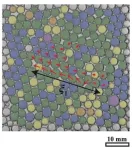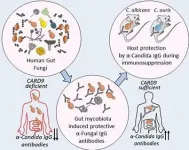Shuffling bubbles reveal how liquid foams evolve
Distinct 'relaxation' identified in foams
2021-02-06
(Press-News.org) Tokyo, Japan - Researchers from Tokyo Metropolitan University studied the dynamics of foams. When a drop of water was added to a foam raft, the bubbles rearranged themselves to reach a new stable state. The team found that bubble movement was qualitatively different depending on the range of bubble sizes present. Along with analogies with soft-jammed materials, these findings may inspire the design of new foam materials for industry.
Foams are everywhere. Whether it's soaps and detergents, meringues, beer foam, cosmetics or insulation for clothing and building, we're surrounded by everyday materials featuring a foam material. The application of foams tends to take advantage of their unique structure, which is why understanding how their structure can change over time is so important.
A team led by Prof. Rei Kurita of Tokyo Metropolitan University have been studying liquid foams, like those made with detergent and water at home. They were interested in understanding how the bubbles of a foam rearrange themselves. While previous studies usually applied a force to the foam with a prod to the side, the team adopted the much gentler method of adding a tiny amount of water, preserving the bubbles but changing the conditions enough for the bubbles to rearrange themselves and find a new stable state. This made it much easier to see how subtle environmental nudges or perturbations lead to small, isolated bubble relaxation events.
By filming the bubbles rearranging themselves, the team showed for the first time that rearrangements were fundamentally different depending on the range of bubble sizes present in the foam. When the bubbles were roughly the same size, or monodisperse, they arranged themselves in a hexagonal, honeycomb formation. Upon adding water, the bubbles that moved tended to shuffle in the same direction over long distances, along the lines of the honeycomb. Conversely, when there were many small and large particles, the initial arrangement was much less ordered. Rearrangements in this polydisperse foam were random, with adjacent bubbles moving in all sorts of directions. The videos they took allowed the team to extract a dynamical correlation length, the length scale over which bubbles move in similar directions. Tracking how this length changes under different conditions is crucial to placing foam materials within the broad framework of condensed matter physics. Interestingly, the unique correlated motion observed in the hexagonal foam didn't depend on adjacent bubbles being in contact: they simply needed to be close enough to form well-ordered patterns.
The team went on to compare this behavior to simulations of packings of soft particles with different ranges of sizes. They found very similar behavior, showing clearly that this was not a quirk of liquid foams, but a general feature of soft particles that have been jammed together. These insights into how foams react to the subtlest of environmental cues may one day inform how foams are kept stable or fluid, and how soft jammed materials are handled in industrial processes.
INFORMATION:
This work was supported by a JSPS Research Fellowship for Young Scientists (20J11840) and JSPS KAKENHI Grants-in-Aid for Scientific Research (17H02945 and 20H01874).
[Attachments] See images for this press release:

ELSE PRESS RELEASES FROM THIS DATE:
2021-02-06
There is an urgent need for guidelines on how schools can use ventilation to reduce the risk of COVID-19 transmission in the classroom, according to doctors at Imperial College London and the headteacher of a secondary school in Pinner, Middlesex. In a commentary published by the Journal of the Royal Society of Medicine, the authors say that improving air quality in classroom spaces should be as important as following government advice regarding social distancing, mask-wearing and hand washing.
The authors point to lessons from the airline industry, where the risk of contracting COVID-19 on a flight ...
2021-02-06
6 February: The IMbrave150 trial found median overall survival was 19.2 months in patients treated with atezo+bev vs 13.4 months for those treated with sorafenib alone, the current standard treatment (HR, 0.66 [95% CI, 0.52-0.85]; P=0.0009). Survival at 18 months was 52% with atezo+bev and 40% in patients treated with sorafenib.
All patients in the trial had nonresectable HCC - the most common form of liver cancer - and had not previously been treated with systemic therapy. A total of 501 patients were treated in the multicentre, open label, randomised controlled trial and the new follow-up figures confirm the superiority of the atezo+bev combination over sorafenib in this group of patients with HCC.
Atezolizumab is an immune ...
2021-02-06
Around one in three working-age adults (29%) surveyed in France in July 2020 would refuse any COVID-19 vaccine.
Willingness to receive a COVID-19 vaccination depended upon its country of origin, effectiveness, rate of serious side effects, and site of vaccination.
Although attitudes may have changed since July 2020 with the approval of several vaccines and a second wave of COVID-19, the findings suggest that communicating the collective benefits of herd immunity reduced people's hesitancy about being vaccinated.
Nearly one in three working-age adults in France (29%) surveyed in July 2020 - when lockdown restrictions had been ...
2021-02-06
TORONTO (February 5, 2021) - A clinical study led by Dr. Jordan Feld, a liver specialist at Toronto Centre for Liver Disease, University Health Network (UHN), showed an experimental antiviral drug can significantly speed up recovery for COVID-19 outpatients - patients who do not need to be hospitalized.
This could become an important intervention to treat infected patients and help curb community spread, while COVID-19 vaccines are rolled out this year.
"This treatment has large therapeutic potential, especially at this moment as we see aggressive variants of the virus spreading around the globe which are less sensitive to both vaccines and treatment ...
2021-02-05
NEW YORK, NY (Feb. 5, 2020)--Cells used to study the human blood brain barrier in the lab aren't what they seem, throwing nearly a decade's worth of research into question, a new study from scientists at Columbia University Vagelos College of Physicians and Surgeons and Weill Cornell Medicine suggests.
The team also discovered a possible way to correct the error, raising hopes of creating a more accurate model of the human blood-brain barrier for studying certain neurological diseases and developing drugs that can cross it.
The study was published online Feb. ...
2021-02-05
Washington, DC, February 5, 2021 - A study in the Journal of the American Academy of Child and Adolescent Psychiatry (JAACAP), published by Elsevier, reports that in a diverse, cross-national sample of youth, physical discipline and cognitive deprivation had distinct associations with specific domains of developmental delay. The findings are based on the Multiple Indicator Cluster Surveys, which is an ongoing, international household survey initiative coordinated and assisted by the United Nations agency, UNICEF.
"Physical discipline and cognitive deprivation are well-established risks to child development. However, it is rare that these experiences are examined in relation to each other," said lead author ...
2021-02-05
UNIVERSITY PARK, Pa.-- When actor Tom Hanks announced his COVID-19 diagnosis on March 11, 2020, many Americans were still learning about the virus and its severity. According to new research, Hanks' announcement may have affected how some people understood the virus and their behavior toward its prevention.
The day after Hanks posted the news on social media, Jessica Gall Myrick, an associate professor in the Donald P. Bellisario College of Communications at Penn State, and Jessica Fitts Willoughby, associate professor at Washington State University, surveyed 682 people about their attitudes and behaviors toward COVID-19.
Just under 90% of the people surveyed had heard about Hanks' social ...
2021-02-05
Virtual reality isn't just for gaming. Researchers can use virtual reality, or VR, to assess participants' attention, memory and problem-solving abilities in real world settings. By using VR technology to examine how folks complete daily tasks, like making a grocery list, researchers can better help clinical populations that struggle with executive functioning to manage their everyday lives.
Lead author Zhengsi Chang is a PhD student that works in the lab of Daniel Krawczyk, PhD, deputy director of the Center for BrainHealth®. Along with Brandon Pires, a researcher at Texas Tech University Health Sciences Center, the team investigated whether VR can be used to effectively test ...
2021-02-05
New research affirms a unique peptide found in an Australian plant can destroy the No. 1 killer of citrus trees worldwide and help prevent infection.
Huanglongbing, HLB, or citrus greening has multiple names, but one ultimate result: bitter and worthless citrus fruits. It has wiped out citrus orchards across the globe, causing billions in annual production losses.
All commercially important citrus varieties are susceptible to it, and there is no effective tool to treat HLB-positive trees, or to prevent new infections.
However, new UC Riverside research shows that a naturally occurring peptide found in HLB-tolerant citrus relatives, such as Australian finger lime, can not only kill the bacteria that causes the disease, it can also activate the plant's ...
2021-02-05
Common fungi, often present in the gut, teach the immune system how to respond to their more dangerous relatives, according to new research from scientists at Weill Cornell Medicine. Breakdowns in this process can leave people susceptible to deadly fungal infections.
The study, published Feb. 5 in Cell, reveals a new twist in the complex relationship between humans and their associated microbes, and points the way toward novel therapies that could help combat a rising tide of drug-resistant pathogens.
The new discovery stemmed from work on inflammatory bowel disease, which often causes patients to carry larger than normal populations of fungi in their guts. ...
LAST 30 PRESS RELEASES:
[Press-News.org] Shuffling bubbles reveal how liquid foams evolve
Distinct 'relaxation' identified in foams



